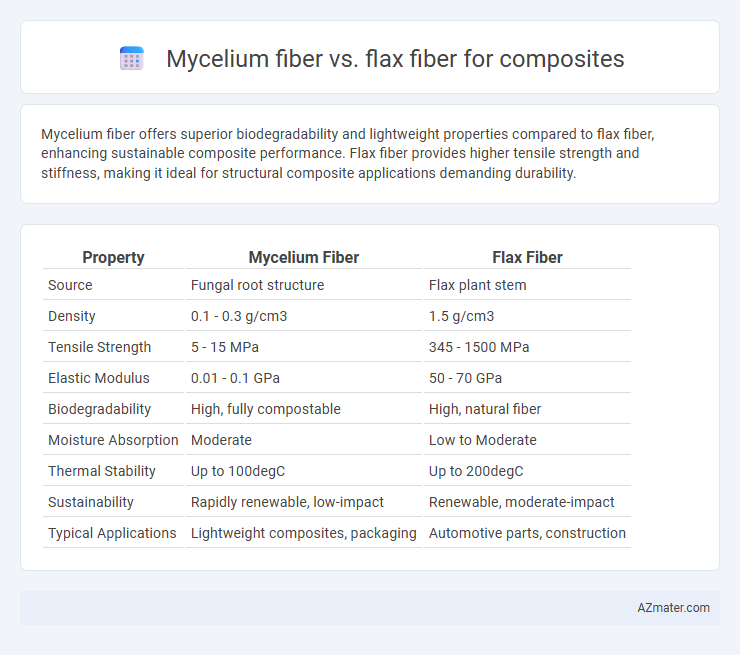Mycelium fiber offers superior biodegradability and lightweight properties compared to flax fiber, enhancing sustainable composite performance. Flax fiber provides higher tensile strength and stiffness, making it ideal for structural composite applications demanding durability.
Table of Comparison
| Property | Mycelium Fiber | Flax Fiber |
|---|---|---|
| Source | Fungal root structure | Flax plant stem |
| Density | 0.1 - 0.3 g/cm3 | 1.5 g/cm3 |
| Tensile Strength | 5 - 15 MPa | 345 - 1500 MPa |
| Elastic Modulus | 0.01 - 0.1 GPa | 50 - 70 GPa |
| Biodegradability | High, fully compostable | High, natural fiber |
| Moisture Absorption | Moderate | Low to Moderate |
| Thermal Stability | Up to 100degC | Up to 200degC |
| Sustainability | Rapidly renewable, low-impact | Renewable, moderate-impact |
| Typical Applications | Lightweight composites, packaging | Automotive parts, construction |
Introduction to Bio-based Fibers in Composites
Mycelium fiber and flax fiber represent two innovative bio-based fibers used in composite materials, offering sustainable alternatives to synthetic fibers. Mycelium fiber, derived from the root structure of fungi, provides lightweight, biodegradable properties with excellent thermal insulation and mechanical strength. Flax fiber, extracted from the flax plant, is renowned for its high tensile strength, low density, and eco-friendly cultivation, making it a popular choice for reinforcing polymer composites in automotive and construction industries.
Overview of Mycelium Fiber
Mycelium fiber, derived from fungal root structures, offers a sustainable and biodegradable alternative to traditional flax fiber in composite materials. Its natural network of hyphae provides excellent mechanical properties, including high tensile strength and flexibility, making it suitable for lightweight and eco-friendly composites. Mycelium fibers also exhibit superior insulation and moisture regulation compared to flax, enhancing performance in various industrial applications.
Overview of Flax Fiber
Flax fiber, derived from the flax plant's stem, is renowned for its high tensile strength, biodegradability, and excellent mechanical properties, making it a preferred natural fiber in composite materials. It offers superior stiffness and low density, contributing to lightweight yet durable composites often used in automotive and construction industries. Flax fiber's natural lignin content enhances its compatibility with various bio-resins, promoting sustainable and environmentally friendly composite applications.
Material Properties Comparison
Mycelium fiber exhibits superior biodegradability and lower density compared to flax fiber, making it an eco-friendly option for lightweight composites. Flax fiber provides higher tensile strength and stiffness, improving structural performance in composite materials. Both fibers offer unique thermal insulation properties, but flax demonstrates better moisture resistance, enhancing durability in humid conditions.
Mechanical Strength and Durability
Mycelium fiber exhibits moderate mechanical strength with flexibility and impact resistance, while flax fiber offers superior tensile strength and stiffness, making it ideal for load-bearing composite applications. Flax fiber composites demonstrate enhanced durability and resistance to environmental degradation compared to mycelium fiber composites, which may be more susceptible to moisture absorption and biodegradation. Optimizing composite formulations can improve the balance between mycelium's biodegradability and flax's mechanical robustness for sustainable engineering solutions.
Sustainability and Environmental Impact
Mycelium fiber and flax fiber are both sustainable options for composites, with mycelium offering rapid biodegradability and low resource consumption due to its fungal origin. Flax fiber provides high strength-to-weight ratio and is renewable, yet requires significant water and land use during cultivation. Environmental impact assessments favor mycelium fiber for lower carbon footprint and minimal agricultural inputs compared to flax fiber's traditional farming practices.
Processing and Manufacturing Techniques
Mycelium fiber undergoes a biofabrication process involving fungal mycelium growth on organic substrates, forming a natural matrix that requires minimal chemical treatment, making it eco-friendly and scalable for composites. Flax fiber processing involves mechanical retting, scutching, and hackling to extract long bast fibers, followed by spinning or weaving, which demands more energy and chemical usage than mycelium production. Manufacturing composites with mycelium requires humid, warm conditions to promote fungal growth within molds, while flax fibers integrate well with polymer matrices through traditional wet lay-up or resin infusion techniques.
Applications in Composite Materials
Mycelium fiber exhibits lightweight, biodegradable properties ideal for sustainable packaging and insulation in composite materials, while flax fiber offers superior tensile strength and stiffness, making it preferred for automotive and construction applications. Flax's natural cellulose content enhances mechanical performance and durability, suited for load-bearing composite panels. Mycelium composites excel in acoustic dampening and thermal insulation, providing eco-friendly alternatives where structural strength is less critical.
Cost Analysis and Market Availability
Mycelium fiber presents a cost advantage over flax fiber due to its rapid growth cycle and utilization of agricultural waste, reducing raw material expenses in composite production. Flax fiber, while established in the market, often incurs higher costs related to specialized cultivation, retting, and processing techniques. Market availability of mycelium fiber is currently limited but expanding as sustainable materials gain traction, whereas flax fiber benefits from widespread commercial supply and mature distribution networks.
Future Prospects and Research Directions
Mycelium fiber and flax fiber are emerging as sustainable reinforcements in composite materials, with mycelium offering superior biodegradability and lightweight properties, while flax provides high tensile strength and environmental benefits. Future research focuses on enhancing the interfacial bonding between mycelium fibers and polymer matrices to improve mechanical performance and exploring hybrid composites combining mycelium and flax fibers for optimized durability and cost-efficiency. Advances in genetic engineering and processing techniques for mycelium and advanced retting methods for flax are key research directions to unlock the full potential of these natural fibers in eco-friendly composite applications.

Infographic: Mycelium fiber vs Flax fiber for Composite
 azmater.com
azmater.com